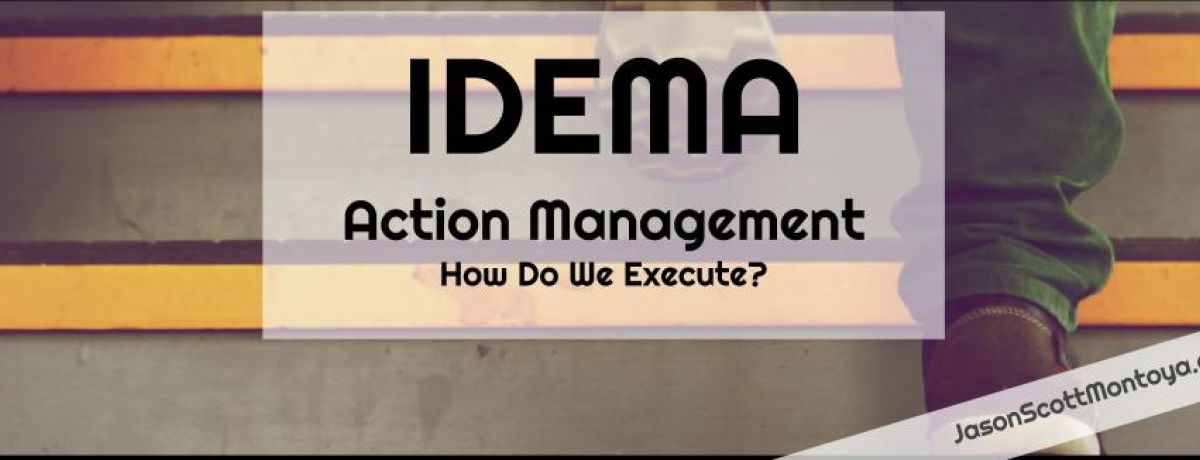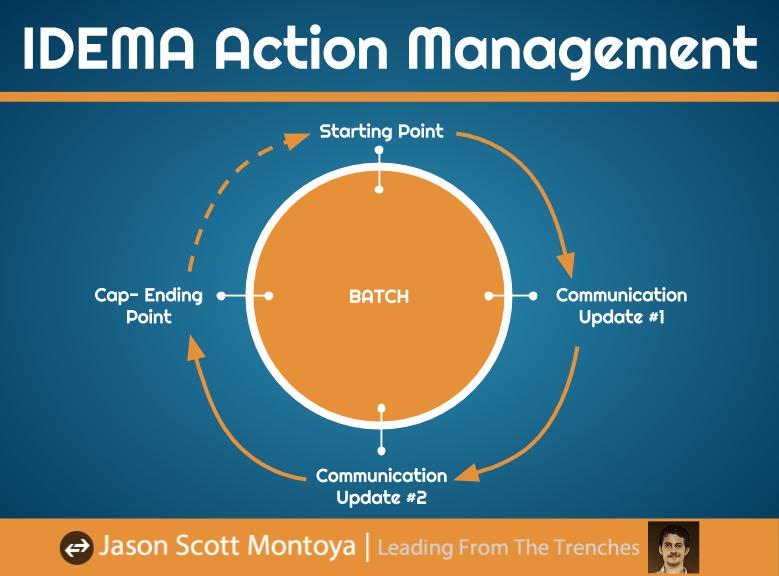IDEMA Action Management Summary
The IDEMA action management system involves high levels of communication and accountability to encourage accuracy and high performance. In the
IDEMA Action Management system, we have three communication tools to help us maximize our precision and effectiveness. These three tools are
checkpoints,
caps and
pace.
Initially we will need to decide our starting point for the project. It may be a company problem we are seeking to solve, or it could be a marketing evaluation.
The work scope can range. From our initial conversation, we will list out the actions we want to execute during our first batch of hours. This is our starting point. From there, we will identify our stopping point (
Cap), our communication check-in points (
Checkpoint) and the speed (
Pace) we want to work at. This allows us the control the spend rate, provides a reasonable amount of updates for the purposes of course correction, and stops the project for re-evaluation systematically. In other words, there should be no surprises and few mistakes.
Who Is A Good Client In This System?
- Someone who wants clarity while their project is being worked on.
- Achievers seeking performance and proactive communication.
- Someone who desires regular entry and exits points while working together.
- Someone who has been burned by vendors who have not delivered on their promises in the past.
An Example Project
A client hired me to evaluate his website to identify how it was ranking on the search engines. This was our starting point. We setup a 10 hour cap with checkpoints at 1 and 5 hours. We ran a pace of 1 batch per week, based on his marketing budget.
In our first hour, I reviewed the website and identified a list of actions we would execute to improve his website search engine rankings. While we continued to work on his search engine optimization, I found and documented gaps in the user experience, marketing channels, email campaigns as well as the aesthetic design of his websites.
In subsequent batches, we tackled these new found marketing actions as directed. Our intent was to go after the lowest hanging fruit, and make changes which would improve what he had now, while considering future potential initiatives. Using this organic approach, we were able to increase his rankings, the user experience and design of his websites. Also we were able to establish a more effective email marketing campaign.
While he was aware of his need for ranking on the search engines, it was the consulting and insight brought through this process which really helped his business grow in ways he was not even considering when we started. After 6 batches of work, his budget was spent and the exit point made it easy to end the engagement. At any point in the future he can reengage where we left off or with something new.
The Action Management System, In Detail
With a brief overview and example, you may be interested in learning more about this system so I have provided an in depth look below. Here is how each step of the process plays out while working together.
Starting Point
For most new clients, beginning with a 10 hour cap, checkpoints at the 3 and 7 hour marks, is a great starting point. Before starting we can determine our pace, or we can execute the actions and decide on our pace after our first batch of hours. After several batches of working together, we will likely find a rhythm which will work best for us.
When it comes to a starting point, many cases start with a known problem or need. In the cases where the client knows the specific need, we will start by tackling it directly. The other scenario is one where the client knows they need help in a particular arena, but they don't know where the starting point is. In these cases, we will launch into our first batch with
an audit. We could audit the company, the marketing department or the website.
The beauty of this system is it allows us to tackle a problem and adjust as we dive into the problem.
Checkpoints
The checkpoints serve primarily as communication updates. At our checkpoints, clients can expect an update with what we have completed, what is in progress and what is yet to be finished. Also in the update is how the project is progressing based on our initial estimates. In response to this update, our efforts can be redirected if we are off course.
Gap Identification
While working on our project, gaps (opportunities for improvement) will be illuminated. As they are illuminated, they will be documented in our action manager tool. These actions will be reviewed during the Cap update detailed below.
Caps
During this stopping point, we will reflect on the illuminated gaps found while working on our project. Some of these may be included in our next batch of hours list. For our Cap update, a client can expect an email of what we have finished, and what I recommend we work on during our next batch of hours, should you decide to continue working together.
Pace
The pace is key in determining our spend rate. At $75/hour, a batch of 10 hours will be $750. We can set a quarterly, monthly, weekly, or daily pace. The beauty of our pace is it allows us to manage the cost, and it gives us the flexibility to increase or decrease our pace based on circumstances.
Overarching Budget
There are situations where an overarching budget needs to be considered. While our pace dictates the rate of money being spent, having an overarching budget creates another tensions to help us prioritize our work. While working through each batch, my prioritization, communication and push back will be partially based on the overarching budget for the project.
How We Organize Our Actions
Understanding how we will work together is the first step. The next important factor is understanding how the actions are organized while we work together.
When it comes to projects, there are three categories I prefer to organize our actions. There is the category of construction actions, ones which when completed, are finished. There are maintenance actions, ones which are recurring in nature, and finally, there are trigger actions, ones which happen based on a triggering event.
After gaps (opportunities for improvement) are identified, they will be documented in our action manager tool. This tool will help us execute our actions in an effective and accountable way. Each Cap update will include a link to this tool.
While there are many great systems for working on projects, this is the system I believe best works within my strengths, weaknesses and personality. It also provides clients a level of clarity and accountability which is above and beyond how most consultants work. If you have any feedback, ideas or thoughts, please share them with me.



